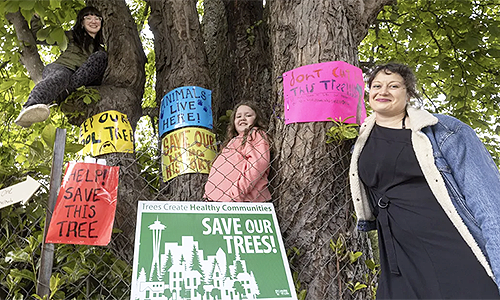
by VIV FORBES – AUSTRALIA is threatened by dangerous trees. They have infested our cities, menace our power lines, invade our grasslands and fuel our worst bushfires.
The meander by Cyclone Alfred through south east Queensland illustrated how bad this danger has become.

- Big tall trees should be lopped to a height that does not endanger other people’s property.
- Grasslands are being destroyed by ignorant green busybodies who prevent burning of dead wood.
- There are now fewer fires, but when they come they’re unstoppable.
Tall trees smashed power lines and more than 450,000 people lost power, some for days; big trees crushed cars and closed roads; and in every cyclone trees fall on houses, shops and fences.
Far too many of these trees damaged other people’s property; and far too often the owners of the trees will not foot the repair bills.
DAMAGES
Those who harbour potentially dangerous trees should be held responsible for damage they do to neighbours or to public property. It needs a couple of claims for damages to focus minds.
And if some greenie with government power prevents a landowner from pruning an unsafe tree, that green bureaucrat should personally pay for all damage done.
To avoid damages claims big tall trees should be lopped to a height that does not endanger other people’s property.
Trees are also causing rural damage.
Our grasslands and open forests were once kept open and grassy by regular burning, first by Aboriginals and later by graziers. Early explorers and colonists marvelled at those lovely weed-free grasslands.
Aboriginal burning was not a planned procedure – it was a result of their lifestyle. Fire was one of their greatest tools, used for warmth, cooking and for creating fresh grass for marsupials, which they hunted for food.
Burning also discouraged mosquitos and sand-flies.
But starting a fire from scratch was tiresome and time consuming. They did not have a box of wax vestas in their dilly bag.
So, when the tribe travelled in search of food, one of the lubras was charged with keeping a flame alive. She carried a burning stick.
When her fire-stick threatened to go out, she shoved it into a tussock of dry grass to rejuvenate its flames. Then she moved on, leaving the tussock burning.
So, lots of patches of grass were burnt, encouraging new growth and attracting grazing marsupials whose protein was a valued Aboriginal food.
Abel Tasman mentioned the columns of smoke he saw in his voyages around Australia in the 1640s.
Captain Cook noticed the smoke from many fires as he sailed up the east coast of Aboriginal Australia in 1770 – he even named “Smokey Cape” in NSW.
He noted that the whole place seemed to be burning.
TREELESS
This widespread burning by Aboriginals discouraged trees and created the great treeless grasslands and open forests that existed when Europeans came.
The early graziers also soon learned to use cool season burning to remove worthless dry grass and replace it by new green shoots as soon as the summer storms brought rain.
They also collected dead branches and fallen trees for firewood, yard rails and posts.
Grasslands and open forests, however, are now being destroyed by ignorant green busybodies who prevent or delay burning and insist that dead wood is allowed to accumulate on the ground. There are fewer fires, but when they come they are unstoppable.
And there are too many “protected” parks and forests where grazing, hunting and collecting dead firewood is banned.
These areas have become havens for weeds like lantana, groundsel, wait-a-while and prickly pear – and for pests like wild cats, wild dogs, wild deer and wild pigs.
Many people have admired our beautiful eucalypt trees and too many have planted eucalypts in their own backyards.
Seeds were sent to Kew Gardens in the UK in 1774 and were soon also being propagated in places like Spain, Portugal, Italy, Morocco, California and South Africa.
In Spain they were promoted for pulp production: “a fast- growing tree species producing abundant pulp in comparison with slow-growing oaks.”
But eucalypts pose a special fire danger – the beauty of “Blue Hills” arises when eucalyptus oils evaporate from the leaves of gum trees in hot sunshine.
This vapour and fine dust in the air above these trees scatter the light producing the blue haze.
But eucalyptus oil is highly flammable. Should lightning, arsonists or careless campers start a bushfire near a eucalypt forest on a hot afternoon, this gas will assist the fire race through the tree tops.
GIGANTIC
David Bowman, a forest ecologist at the University of Tasmania, had this to say: “Looking at the eucalyptus forest outside my window, I see a gigantic fire hazard. On a really hot day, those things are going to burn like torches and shower our suburbs with sparks.”
Once upon a time, Australian landowners were obliged to keep their land free of eucalypt regrowth – it was a condition of their leases.
Inspectors checked on them to ensure they were had cleared the land and were controlling suckers.
Now landowners are the suckers – if woody weeds reach a certain size, they become protected native plants.
Bureaucratic spies now use satellite data to catch landowners in illegal clearing.
Soon the remaining grass is smothered and the land turns to worthless scrub harbouring weeds and animal pests.
And a haven for fierce bushfires.PC











